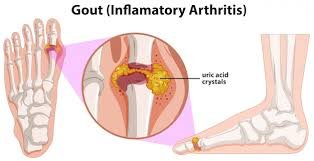Gout arthritis is a form of inflammatory arthritis characterized by sudden and severe attacks of pain, swelling, redness, and tenderness in the joints, most commonly the big toe. It is caused by an accumulation of uric acid crystals in the joints, leading to inflammation and pain. Gout is often associated with lifestyle factors such as diet, alcohol consumption, obesity, and genetics. Treatment for gout arthritis typically includes medications to reduce inflammation and pain, as well as lifestyle changes to manage uric acid levels in the body. If left untreated, gout can lead to joint damage and other complications, so it is important to seek medical attention for proper diagnosis and management.
The most common symptom of gout arthritis is intense pain in the affected joint, often in the big toe. Other symptoms may include swelling, warmth, and redness in the affected joint, as well as limited range of motion. Gout attacks can come on suddenly and typically peak within 24 hours. In some cases, individuals may also experience fever and fatigue during an attack.
Diet – Diet plays a crucial role in managing gout arthritis, as certain foods can trigger flare-ups and worsen symptoms. It is recommended for individuals with gout arthritis to limit their intake of foods high in purines, such as red meat, organ meats, and shellfish. Instead, focus on a diet rich in fruits, vegetables, whole grains, and low-fat dairy products. Drinking plenty of water and avoiding sugary beverages can also help to reduce uric acid levels in the body.
Exercise – Exercise can be an important component of managing gout arthritis. While it is important to consult with a healthcare professional before starting any new exercise routine, low-impact activities such as walking, swimming, or yoga can help improve joint flexibility and reduce inflammation associated with gout arthritis. Strengthening exercises targeting the muscles surrounding the affected joints can also help provide support and stability. It is important to start slowly and gradually increase intensity to avoid exacerbating symptoms. Additionally, maintaining a healthy weight through regular exercise can help reduce the risk of gout flare-ups.
It is important to consult with a healthcare professional for an accurate diagnosis and appropriate treatment plan.
